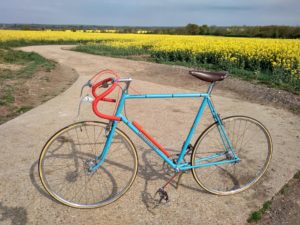Bars: Steel, unknown maker. Stem: GB 531
Brakes: GB Hiduminium
Chainset, Pedals: Chater-Lea
Saddle: Brooks B17 Narrow
Gears: Sturmey Archer AC close ratio
Wheels: BH Airlight Continental front hub. Rims (temporarily) Fiamme sprints
Pump: Bluemel
Jack Manning was a leading member of the Charlotteville CC in the late ’30s and post war till the early ’50s. See his palmares here. Being a well-built and strong man he was particularly keen to avoid breakages, so favoured steel components rather than lighter options. This bike was his post-war road bike, purchased by me as a frame with b/b and headset, then fitted with components as advised by Les Bowerman. The paintwork is original, and good enough to be touched in and preserved rather than restored. Of particular interest is Jack’s use of a close-ratio Sturmey Archer AC hub, (his ‘Cocoa Tin’) particularly as we have a photo (possible pre-war) showing he raced with a Super-Champion ‘Osgear’ – presumably in a time trial as he is wearing an alpaca jacket and leggings. #4146 has no evidence of being fitted with anything other than a hub gear, so that’s how it has been restored.
Sturmey Archer hub gears were used as early as 1913 in the Tour de France (Petit-Breton), the 1938 Empire games, and in 1956 by Ray Booty in his straight-out RRA 100 record of 3:28:40. As 3-speed hubs they offered a mechanical efficiency similar to (if not better than) contemporary 3-speed derailleur gears. This was OK for flat road time trials and RRA records, but after Percy Stallard’s initiative, hillier road-races were growing in popularity. These demanded a wider gearing spread, still with fairly small increments. Going above 3 speeds in a hub gear entails fitting a second cage of planet gears, adding complexity, drag and weight. The advantages of the derailleur systems (together with the more flexible 3/32″ chains they used) overcame the pre-occupation with accurate chain-line. They evolved steadily, especially for the continental road-racing scene. In Britain BLRC road racers immediately adopted them. Finally derailleurs displaced fixed-gears on the time-trial scene. It was plunger-spring models that held sway until 1953 when Campagnolo’s Gran Sport 5-gear parallelogram swept all aside. Despite Sturmey Archer’s marketing efforts like their close-ratio AC model (106.66%, 100%, and 93.3% ‘1-tooth increment’) for TTs and publicity from Ray Booty’s place-place record achievements, hub gears never became established in competitive cycling. Carpenter listed a ‘SA Speed Ace’ model in his brochures but it’s rather unusual to find an example of a race machine.
